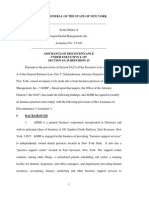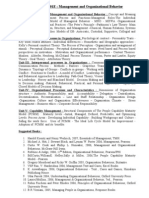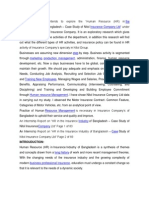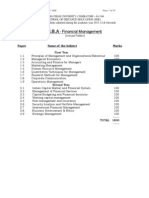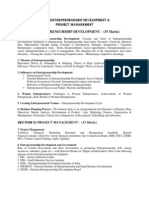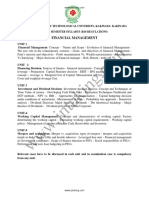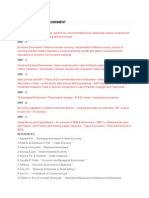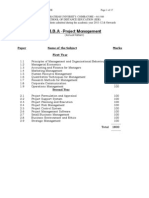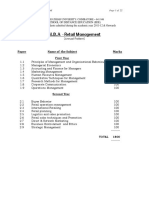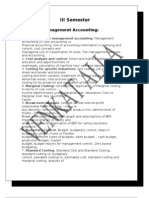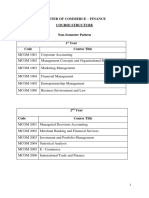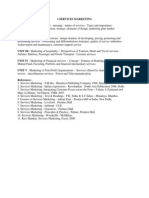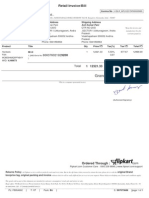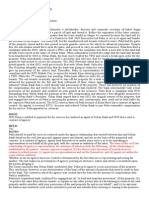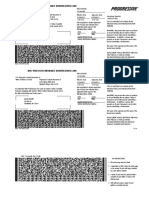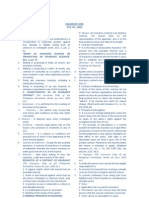MBA 3rd Sem Syllabus
MBA 3rd Sem Syllabus
Uploaded by
Santosh KapilCopyright:
Available Formats
MBA 3rd Sem Syllabus
MBA 3rd Sem Syllabus
Uploaded by
Santosh KapilCopyright
Available Formats
Share this document
Did you find this document useful?
Is this content inappropriate?
Copyright:
Available Formats
MBA 3rd Sem Syllabus
MBA 3rd Sem Syllabus
Uploaded by
Santosh KapilCopyright:
Available Formats
I III L P Credits
4 - 3
STRATEGIC MANAGEMENT
UNIT-I
Introduction: Concepts in Strategic Management, Strategic Management
as a process Developing a strategic vision, Mission, Objectives, Policies
Factors that shape a companys strategy Crafting a strategy - Industry
and Competitive Analysis
UNIT -II
Environmental Scanning and leadership: Methods. SWOT Analysis
Strategies and competitive advantages in diversified companies and its
evaluation. Strategic Analysis and Choice: Tools and techniques- Strategic
Leadership: Leadership and Style Key Strategic Leadership Actions -
Developing Human Capital and Social Capital Balanced Scorecard.
UNIT -III
Strategy Formulation : Strategy Framework For Analyzing
Competition, Porters Value Chain Analysis, Competitive Advantage of a
Firm, Exit and Entry Barriers - Formulation of strategy at corporate,
business and functional levels. Types of Strategies Tailoring strategy to
fit specific industry restructuring and diversification strategies
different methods Turnaround strategy and diversification strategies.
UNIT -IV
Strategy Implementation : Strategy and Structure, Leadership, culture
connection - Strategies for competing in Globalizing markets and internet
economy Organizational Values and Their Impact on Strategy
Resource Allocation Planning systems for implementation.
UNIT -V
Strategy Evaluation and control Establishing strategic controls -
Measuring performance appropriate measures- Role of the strategist
using qualitative and quantitative benchmarking to evaluate performance -
strategic information systems problems in measuring performance
Strategic surveillance -strategic audit
Relevant cases have to be discussed in each unit and in examination
case is compulsory from any unit.
REFERENCES
1 . Vijaya Kumar P,. Hitt A : Strategic Management, Cengage
learning, New Delhi,2010
2. John A PearceII, Amita Mital: Strategic Management,
TMH, New Delhi, 2012.
3. Sanjay Mohapatra: Cases Studies in Strategic
Management, Pearson, New Delhi,2012
4. Adrian Haberberg&Alison: Strategic Management, Oxford
University Press, New Delhi, 2010
5 . P.Subba Rao: Business Policy and Strategic Management
Text and Cases, Himalaya Publishing House, New Delhi, 2011
6. Appa Rao, Parvatheshwar Rao, Shiva Rama Krishna:
Strategic Management and Business Policy, Excel
Books, New Delhi, 2012
7 Edward Freeman R: Strategic Management, Cambridge
University Press,New Delhi, 2011.
8. U.C.Mathur: Strategic Management, MacMillan Pulishers,
New Delhi, 2010
9. R.Srinivasan: Strategic Management, PHI Learning, New
Delhi, 2012
10. Nag A: Strategic Management, Vikas Publishing House,
New Delhi, 2011.
11. S.K.Sarangi:Modern Strategic Management, Everest
Publishing House,New Delhi, 2010.
I III L P Credits
4 - 3
LEGAL ASPECTS OF BUSINESS
UNIT -I
Importance of Commercial Law: The Indian Contracts Act, 1872 Nature
of the Act and Classification of Contracts Essentials of a Valid Contract
Offer and Acceptance Capacity Consideration Free Consent
Legality of Object Performance of a Contract Discharge of a Contract
Breach of a Contract and Remedies.
UNIT -II
Sales of Goods Act: Distinction between Sales and Agreement to Sell
Conditions and Warranties Performance of Contract of Sale Transfer
of Ownership Rights of an Unpaid Seller. Consumer Protection Act,
1986: Consumer Right Machinery for Redressal of Consumer
Grievances.-Information Technology Act 2000.
UNIT -III
Contract of Agency: Kinds of Agents Creation of Agency- Duties and
Rights of Principal and Agents- Principals Liability for the Acts of the
Agent-Liability of Agent Termination of Agency. Negotiable
Instruments Act, 1881- Kinds of a Negotiable Instruments and
endorsement- Presentation and discharge of Negotiable Instrument.
UNIT-IV
Indian Partnership Act, 1932: Meaning and Essentials of Partnership-
Registration Tests of Partnership-Duties and Rights of Partners
Dissolution of Partnership.
UNIT -V
Company Act 1956-Nature and Types of Companies Formation
Memorandum of Association-Articles of Association Kinds of Shares
Duties of Directors-Winding up.
Relevant cases have to be discussed in each unit and in examination
case is compulsory from any unit.
REFERENCES
1. Ravindra Kumar: Legal Aspects of Business, Cengage
Learning, New Delhi, 2011
2. Kuchhal M C, Deepa Prakash: Business Legislation for
Management, Vikas Publishing House, New Delhi, 2012
3. Pathak: Legal Aspects of Business, Tata McGraw Hill,
New Delhi, 2010
4. S.N.Maheshwari, S.K.Maheshwari: A Manual of Business
Laws, Himalaya Publishing House, 2013.
5. P.K.Padhi: Legal Aspects of Business, PHI Learnings, New
Delhi, 2013
6. S.S Gulshan: Business Law, Excel Books, New Delhi, 2012
7. Daniel Albuquerque: Legal Aspects of Business, Oxford
University Press, New Delhi, 2013
8. S.S.Gulshan, G.K.Kapoor: Business Law Including
Company Law, New-Age Publishers, New Delhi, 2011
9. Tejpal Sheth: Business Law, Pearson, New Delhi, 2012.
10. N.M.Vechalekar: Business Law, Everest Publishing House,
New Delhi, 2011.
I III L P Credits
4 - 3
RETAIL MANAGEMENT
UNIT-V
Basic concept of retailing retail development types and functions of
retailers multi channel retailing organized retailing in India special
characteristics of retailing
services retailing- legislation for retailing in India.
UNIT -II
Retail strategy: market strategy retail format and target market
building sustainable competitive advantage growth strategies strategic
retail planning process.
UNIT-III
Retail location types, location opportunities selection of location and
Site analysis - financial strategy strategic profit model setting and
measuring performance objectives.
UNIT-IV
Store layout and design, store operations and inventory management-
merchandise planning and control, buying merchandise developing
assortment plan.
UNIT -V
Retail pricing strategy, category management, customer services retail
branding- International retailing promotional strategies advertising,
sales promotion, store atmosphere.
Relevant cases have to be discussed in each unit and in examination
case is compulsory from any unit.
46 2013-14
REFERENCES
1. Sheikh and Kaneez Fatima, Retail Management, Himalaya
Publishing House, Mumbai, 2012
2. A.J. Lamba:The Art of Retailing, Tata McGraw Hill
Education Pvt. Ltd. New Delhi.2011
3. Sivakumar, A, Retail Marketing, Excel Books, New Delhi, 2007
4. Swapna Pradhan, Retail management, Tata McGraw Hill
Education Pvt. Ltd. New Delhi, 2012
5. Berman Barry, Joel R. Evans and Mini Mathur, Retail
Management-A Strategic Approach, Pearson Education,
New Delhi, 2011.
6. Chetan Bajaj RajnishTuli, Nidhivarma Srivastava:Retail
Management, Oxford University Press, New Delhi, 2012.
7. Gibson G Vedamani, Retail Management, Jaico Publishing
House, New Delhi.
8. Dunne: Introduction to Retailing, Cengage Learning, New
Delhi, 2013
I III L P Credits
4 - 3
(HRM-ELECTIVE-I)
COMPENSATION AND PERFORMANCE
MANAGEMENT
UNIT -I
Compensation: concept and definition objectives and dimensions of
compensation program factors influencing compensation aligning
compensation strategy with business strategy concept of reward - non-
financial compensation system - Managing Compensation: Designing a
compensation system internal and external equity pay determinants -
frame work of compensation policy - influence of pay on employee
attitude and behavior - the new trends in compensation management at
national and international level.
UNIT-II
Wage concepts and theories: minimum wages, fair wages, living wages
money and real wages wage theories wage incentives - classification of
incentives, incentive systems, wage incentives in India, recommendations of
the National Commission on Labor fringe benefits - wage differentials
linking wage with productivity. Executive compensation trends
welfare measures statutory and non-statutory.
UNIT-III
Wage and Salary administration: Nature and importance job analysis
methods - job evaluation - wage determination process methods of wage
fixation wage structure - multi-dimensional approach wage problems
wage surveys wage administration economic objectives of wage policy
legal frame work The payment of Wages Act 1936, The Minimum
Wages Act 1948 and other similar act and amendments institutional
mechanism for wage determination
UNIT-IV
Performance Management: Importance - methods- process- Definition,
concepts and scope Goal Setting- Linkages to Strategic Planning-
Competency mapping- Performance Management System: objectives
Functions
Performance Management Cycle- Competency based Performance
Management Systems- Reward based Performance Management Systems-
Electronic Performance Management Systems-Performance Management
Tools: Importance- Traditions and Modern Techniques- Balanced Score
Card- 360 Degree Performance Apprising- Merit Rating- MBO- BARS
UNIT-V
Unit 6: Appraising for Recognition & Reward: Purpose of Appraising
Methods of appraisal appraisal system design Implementing the appraisal
system Organizational effectiveness - Performance management skills
Building and leading High performing teams Performance Monitoring and
Counseling: Introduction- Supervision- Objectives and Principles of
Monitoring- Monitoring Process- Periodic reviews- Problem solving- Role
efficiency- Coaching- Counseling and Monitoring- Performance Audit.
Relevant cases have to be discussed in each unit and in examination
case is compulsory from any unit.
REFERENCES
1. T.V.Rao: Performance Management Appraisal Systems,
Sage Publications, 2008
2. A.M.Sarma, N.Sambasiva Rao: Compensation and
Performance management, Himalaya Publishing House,
Mumbai
3. Dewakar Goel:Performance Appraisal and Compensation
Management, PHI Learning, New Delhi, 2012
4. B.D.Singh: Performance Management Systems Excel Books,
New Delhi,2010
5 A.S. Kholi: Performance Management, Oxford University
Press, New Delhi,2012
6 Prem Chadha: Performance Management, Macmillan
India, New Delhi, 2008.
7. Bagchi: Performance Management, Cengage Learning,
New Delhi, 2012.
8. Topomoy DEB: Compensation Management, Excel
Books, New Delhi, 2009
9. George T Milkovich, JerryM Newman, C.S.Venkatratnam:
Compensation, TMH, New Delhi, 2013
I III L P Credits
4 - 3
(HRM-ELECTIVE-II)
MANAGEMENT OF INDUSTRIAL RELATIONS
UNIT -I
Industrial Relations Management Concept- Evaluation Background of
industrial Relations in India- Influencing factors of IR in enterprise and
the consequences. Economic, Social and Political environments-
Employment Structure Social Partnership-Wider approaches to industrial
relations-Labour Market.
UNIT -II
Trade Unions- introduction-Definition and objectives-growth of Trade
Unions in India-trade Unions Act , 1926 and Legal framework-Union
recognition-Union Problems-Employees Association-introduction
,Objective Membership, Financial Status.
UNIT-III
Quality of Work Life: Workers Participation in Management - Workers
Participation in India, shop floor, Plant Level, Board Level- Workers
Welfare in Indian scenario- Collective bargaining concepts &
Characteristics Promoting peace.Wage and Salary administration:
Nature & Significance of wage, salary administration, essentials-
Minimum wage- Fair wage, Real wage, Incentives & fringe benefits.
Issues and Constraints in Wage Determination in India.
UNIT-IV
Social Security: introduction and types Social Security in India, Health
and Occupational safety programs- Salient features of Workmen
Compensation Act and Employees State Insurance Act relating to social
security Workers education objectives -Rewarding.
UNIT -V
Employee Grievances Causes of Grievances Conciliation, Arbitration and
Adjudication procedural aspects for Settlement of Grievances Standing
Orders- Code Discipline. Industrial Disputes: Meaning, nature and scope
of industrial disputes - Cases and Consequences of Industrial Disputes
Prevention and Settlement of industrial disputes in India.
Relevant cases have to be discussed in each unit and in examination
case is compulsory from any unit.
REFERENCES
1. C.S Venkataratnam: Industrial Relations, Oxford
University Press, New Delhi, 2011
2. Sinha: Industrial Relations, Trade Unions and Labour
Legislation, Pearson Education, New Delhi, 2013
3. Mamoria: Dynamics of Industrial Relations, Himalaya
Publishing House, New Delhi, 2010
4. B.D.Singh: Industrial Relations Excel Books, New
Delhi, 2010
5. Arun Monappa: Industrial Relations, TMH, New Delhi. 2012
6. Prof. N.Sambasiva Rao and Dr. Nirmal Kumar: Human
Resource Management and Industrial Relations,
Himalaya Publishing House, Mumbai
7. Ratna Sen: Industrial Relations, MacMillon Publishers,
New Delhi, 2011
8. S.C.Srivatava: Industrial Relations and Labour Laws,
Vikas Publishing House, New Delhi, 2013.
9. R.Sivarethinamohan: Industrial Relations and Labour
Welfare, PHI Learning, New Delhi, 2010.
10. Amandeep Kaur: Industrial Relations, Kalyani
Publishers, New. Delhi,2010.
I III L P Credits
4 - 3
(MKT-ELECTIVE-I)
PRODUCT MANAGEMENT
UNIT-I
Basic concept of Product- Product planning Defining Market strategies for
leaders, challengers, Followers. Product life Cycle and market evaluation
product differentiation and deletions. Product Portfolio Analysis
UNIT-II
New Product Development: Categories of New Product New product
Development - New Product Launch product modification pricing
decision customer and competitor analysis product forecasting and
financial analysis
UNIT -III
Concept of Branding: Traits of Successful Brands Brand Positioning
Anatomy of Brand Leveraging Brands, Brand equity, Brand extension
and Brand Building. Model for Global Brand Building
UNIT -IV
Marketing Organisation: Market Testing Launch Management
Marketing Metrics Public policy Issues Product liability-
Environmental needs Sale methods- Brand Repositioning - Channel
Management Customer Relationship Management
UNIT -V
Packaging: Introduction Advantages and Importance of Packaging -
Packaging design Consumer protection. Product Piracy, Worthy
Products - Personal ethics and Residual Issues - Packaging trends in India.
Relevant cases have to be discussed in each unit and in examination
case is compulsory from any unit.
REFERENCES
1. K.S.Chandrasekar: Product Management-Text, Applications and
Cases, Himalaya Publishing House, New Delhi.
2. Donald R. Lehmann, Russell S.Winer: Product Management,
TaTa McGraw-Hill, New Delhi.
3. S.A. Chunawalla: Product Management, Himalaya Publishing
House, New Delhi.
4. Merle Crawford, Anthony Di Benedetto, New Product
Management, TaTa McGraw-Hill, New Delhi.
5. Ramanuj Majumdar: Product Management in India, PHI
Learning, New Delhi.
I III L P Credits
- - 3
(MKT-ELECTIVE-II)
PROMOTION AND DISTRIBUTION MANAGEMENT
UNIT -I
Sales Promotion: Definition, role, types, consumer sales promotion,
dealer display contests, discounts, bonus offers, retail merchandising
techniques. Publicity: Public relations campaign, use of press, radio and
TV, opinion building, customer service and community service.
UNIT -II
Advertising: Changing concept, role of advertising in a developing
economy, a critical appraisal, types of advertisement for consumer,
industrial, institutional, retail, trade and professional, advertisement in
marketing mix. Pre-testing, post testing, experimental designs
UNIT -III
Organizing for Advertising: Advertising department , objectives and
functions - Role of advertisement agencies, skills and service, client
agency relationship.Public Relations, Publicity and corporate advertising.
Publicity, power of publicity, control and dissemination of publicity,
advantages and disadvantages.
UNIT -IV
Advertisement budgets: Types, determining optimal expenditure, decision
models, sales response and decay, communication, Ad media: media
selection, optimizing approaches, scheduling, research- Sources of themes:
Adapting presentation to medium campaign, USP, brand image, positioning,
purchase proposition and creative interpretation, insertions, contract.
UNIT-V
Contours of Distribution Management Wholesaling Retail theories
and Formats Physical Distribution Management Transportation and
Traffic Management Warehousing and Storage.
Relevant cases have to be discussed in each unit and in examination
case is compulsory from any unit.
REFERENCES
1. Krishna K Havaldar, Vasant M Cavale: Sales and Distribution
Managment, TMH, 2011.
2. S.L.Gupta: Sales and Distribution Management, Excel
Books, New Delhi, 2010
3. S.A.Chunawalla: Advertising, Sales and Promotion
Management, Himalaya Pubishing House, New Delhi,2012
4. Richard R. Still,Edward W. Cundiff, Norman A. P. Govoni:
Sales Management, Pearson New Delhi, 2013
5 George E Belch, Michael A Belch, Keyoor Purani: Advertising
and Promotion: An IntegratedMarketing Communication
Perspective, TMH, New Delhi,2012
6 A.S.Gupta: Advertising and Sales Promotion, Everest
Publishing House, New Delhi, 2010
7 Tapan K.Panda, Sunil Sahadev: Sales and Distribution
Management, Oxford University Press, New Delhi, 2010
8 Pingali Venugopal: Sales and Distribution Management ,
SAGE Publication, New Delhi,2012
I III L P Credits
4 - 3
(FIN-ELECTIVE I)
INVESTMENT MANAGEMENT
UNIT -I
Investments: Definition of investment, Investment Decision Process; Sources
of investment information; Real investment vs. financial investment,
Investment vs. Speculation; Factors to be considered in investment decision:
Liquidity, Return, Risk, Maturity, Safety, Tax and Inflation. The concept and
measurement of realized return and expected return. Ex-ante and ex-post
returns. Measurement of risk-range. Risk-return trade-off. Risk premium and
risk aversion. Approaches to investment analysis-Fundamental and Technical
Analysis; Efficient Market Hypothesis.
UNIT -II
Fixed Income Securities - Analysis, Valuation and Management Features
and types of debt instruments, Bond indenture, factors affecting bond
yield. Bond yield measurement-Current yield, holding period return,
YTM, AYTM and YTC. Bond valuation: Capitalization of income
method, Bond-price theorems, Valuation of compulsorily/optionally
convertible bonds, Valuation of deep discount bonds. Bond duration,
Macaulays duration and modified Macaulays duration. Bond
immunization, active and passive bond portfolio management strategies.
UNIT-III
Common Stocks - Analysis and Valuation: Basic Features of Common
Stock, Approaches to valuationBalance sheet model, dividend
capitalization models; earnings capitalization models; Price-Earnings
multiplier approach and capital asset pricing model, Free Cash flow
model, relative valuation using comparables-P/E,P/BV, P/S; Security
Market Indexes, their uses; computational procedure of Sensex and Nifty.
UNIT -IV
Portfolio Theory: Concept of portfolio. Portfolio return and risk. Harry
Markowitzs Portfolio theory, construction of minimum risk portfolio, the
single-index model. Capital market theory: Introduction of risk-free asset,
Capital Market Line (CML), Security Market line (SML). Capital asset
pricing model (CAPM): over-pricing and under-pricing securities. Arbitrage
pricing theory (APT): The Law of one price, two factor arbitrage pricing,
Equilibrium risk-return relations. A synthesis of CAPM and APT.
UNIT -V
Mutual Funds and Portfolio Evaluation: Mutual funds: genesis, features,
types and schemes. NAVs, costs, loads and return of mutual funds,
Problems and prospects in India, Regulation of mutual funds and
investors protection in India. Performance measures- Sharpes reward to
variability index, Treynors reward to volatility index, Jensens
differential index, Famas decomposition of returns.
Relevant cases have to be discussed in each unit and in examination
case is compulsory from any unit.
REFERENCES
1. Alexander. G.J, Sharpe. W.F and Bailey. J.V, Fundamentals
of Investments, PHI,
2. Reilly, Brown: Analysis of Investments and Management
of Portfolios, Cengage Learning, New Delhi, 2013
3. Prasanna Chandra, Investment Analysis and Portfolio
Management, TMH, New Delhi, 2013
4. Charles.P.Jones, Investments: Analysis and Management,
John Wiley &Sons, Inc. 9th Ed.
5. Francis. J.C. & Taylor, R.W., Theory and Problems of
Investments. Schaums Outline Series, TMH, New Delhi,
6. Preeti Singh, Investment Management, Himalaya Publishing
House. New Delhi.
7. Peter L. Bernstein and Aswath Damodaran, Investment
Management, Wiley Frontiers in Finance.
8. Shashi and Rosy: Security Analysis and Portfolio
Management Investment Management, Kalyani Publishers,
New Delhi 3rd edt.
9. Dhanesh Khatri, Investment Management and Security
Analysis;Text and Cases, Macmillan Publishers. New Delhi, 2011
10. Sudhindra Bhat, Security Analysis and Portfolio
Management, Excel Books.32
11. Punithavathy Pandian, Security Analysis and Portfolio
Management, Vikas Publishing House, New Delhi.
12. V.K.Bhalla: Fundamentals of Investment Management,
S.Chand, New Delhi, 2013
I III L P Credits
4 - 3
(FIN-ELECTIVE-II)
BANKING AND INSURANCE
UNIT -I
Introduction to Banking: Introduction to Indian Financial System - Meaning
of a Bank and Customer- Bank and customer Relationship - Role of
commercial banks in Economic Development - Evolution of Banking in India
origin, nationalization, reforms and Financial Inclusion in India -
Financial statements of banks with special focus on Indian banks -
Financial statement analysis of banks: CAMEL Approach, Key
Performance indicators- Sources of Bank Funds.
UNIT -II
Uses of Bank Funds: Features of Bank Credit - types of lending -
assessment of credit worthiness of a prospective borrower - management
of credit process - different types of loans and their features - Loan
Pricing: The basic model, pricing fixed & floating rate loans, cost-benefit
loan pricing, Customer Profitability Analysis - Non Performing Assets: -
gross and net concept of NPAs, causes, implications & recovery of NPAs.
UNIT -III
Regulation and Innovations in Banking System: Regulation of Bank
Capital: The need to regulate Bank Capital - Concept of Economic Model
- Concept of Regulatory Capital, Basel Accords I,II and III.
Banking Innovations:-Core Banking Solution - Retail Banking - Products
& Services: Nature, Scope, Future and Strategies - Plastic Money -
National Electronic Funds Transfer - ATM - Mobile Phone Banking - Net
Banking-Banc-assurance. Changing role of Banks as Financial
Intermediaries. Customer service quality in Indian banking industry.
UNIT -IV
Introduction to Insurance: Insurance as a Risk Management Tool- Principles
of Insurance - Characteristics of Insurance contract - Functions of Insurers:
Master of Business Administration 59
Production, Underwriting, Rate Making, Managing Claims and Losses,
Investment & Financing, Accounting & Record Keeping and other
miscellaneous functions - Types of Insurers- Concept of Reinsurance, uses
and advantages - Marketing channels: Agents & brokers professionalism,
remuneration, responsibilities, classification, criteria for appointment and
capital adequacy norms for broker - an overview of IRDA.
UNIT -V
Life Insurance and General Insurance: The concept of Life Insurance -
types of Life Insurance contracts - Tax treatment of Life Insurance- Life
Insurance Products- Classification of Life Insurance - The Actuarial
Science- Provisions of Life Insurance contracts - Special Life Insurance
forms - Health and General insuranceOverview, Types, Third Party
Administrators- Micro Insurance in India
Relevant cases have to be discussed in each unit and in examination
case is compulsory from any unit.
REFERENCES
1. Vijayakumar P., Srinivasa Subbarao P., Himalaya
Publication, New Delhi.
2. Peter.S.Rose & Sylvia. C. Hudgins: Bank Management &
Financial Services, Tata McGraw Hill New Delhi, 2010,
3. James S. Trieschmann, Robert E. Hoyt & David. W. Sommer
B:Risk Management & Insurance, Cengage Learning,
New Delhi
4. Reddy K S and Rao R N: Banking & Insurance,
Paramount Publishing House 2013.
5. Vasant Desai: Banks & Institutional Management,
Himalaya Publishing House 2010.
6. R.K.Sharma, Shashi and Jagwant: Banking and
Insurance, , Kalyani Publishers, 16
th
edition.
7. Emmett J. Vaughan & Therese M. Vaughan: Fundamentals
of Risk & Insurance, Wiley, India Edition.
www.jntuworld.com || www.android.jntuworld.com
Master of Business Administration
45
8. H. Narayanan: Indian Insurance A Profile, Jaico Publishing House, New Delhi.
9. Harold. D. Skipper & W. Jean Kwon: Risk Management & Insurance, Perspectives in a Global
Economy, Blackwell Publishing New Delhi.
10. S. Aruna Jatesan, T.R. Viswanathan: Risk Management & Insurance, MacMillan New Delhi.
11. Mark. S.Dorfman: Introduction to Risk Management & Insurance, Prentice-Hall of India Private
Limited
12. NIA: Life Insurance Principles and Practices, Cengage Learning, New Delhi,2013.
13. Neelam C.Gulati: Banking and Insurance: Principles and Practice, Excel Books, New Delhi 2011.
You might also like
- Schneiderman's Settlement With Aspen Dental ManagementDocument40 pagesSchneiderman's Settlement With Aspen Dental Managementrobertharding22100% (1)
- Ratio Analysis Bajaj AllianzDocument104 pagesRatio Analysis Bajaj Allianzdeepak Gupta50% (2)
- Syllabus Osmania University MbaDocument36 pagesSyllabus Osmania University Mbaashishnova100% (5)
- Internship Report On HR of InsuranceDocument50 pagesInternship Report On HR of InsuranceSabila Muntaha Tushi0% (1)
- Jntuk Mba III Sem r13Document26 pagesJntuk Mba III Sem r13j2ee.sridhar7319No ratings yet
- MBA III& IV Semesters PapersDocument24 pagesMBA III& IV Semesters PapersbharathirameshNo ratings yet
- BhU MBA (MKTG) III Sem SyllabusDocument7 pagesBhU MBA (MKTG) III Sem SyllabusSesha KeerthiNo ratings yet
- Mba Regular - r16 III Semester SyllabusDocument27 pagesMba Regular - r16 III Semester SyllabusratnamsNo ratings yet
- R16 MBA III SemDocument21 pagesR16 MBA III SemGangadhara RaoNo ratings yet
- Jntuk Mba III Sem r13Document26 pagesJntuk Mba III Sem r13Manjeet Tanwar100% (1)
- MBA I Sem SYLLABUS PondiDocument5 pagesMBA I Sem SYLLABUS PondiSocrates CtNo ratings yet
- MBA SyllabusDocument56 pagesMBA SyllabusYahya MohammadNo ratings yet
- Relevant Cases Have To Be Discussed in Each Unit and in Examination Case Is Compulsory From Any UnitDocument11 pagesRelevant Cases Have To Be Discussed in Each Unit and in Examination Case Is Compulsory From Any UnitUday KiranNo ratings yet
- MBA (Marketing Management)Document27 pagesMBA (Marketing Management)shwetavimanyu0% (1)
- Mba - FT & PTDocument7 pagesMba - FT & PTNawin KumarNo ratings yet
- Bam 101: Principles of Management Objective: To Provide A Comprehensive Introduction To The Study of ManagementDocument36 pagesBam 101: Principles of Management Objective: To Provide A Comprehensive Introduction To The Study of Managementfred-yusuff tomiwaNo ratings yet
- Financial Management: Paper Name of The Subject MarksDocument16 pagesFinancial Management: Paper Name of The Subject MarksRohithShettigarNo ratings yet
- Iisem MbaDocument9 pagesIisem MbaPSBALARAMNo ratings yet
- 7 CommerceDocument29 pages7 CommerceSandeep dasNo ratings yet
- SyllabusDocument9 pagesSyllabusSumit ChoudharyNo ratings yet
- University Updates: Financial ManagementDocument10 pagesUniversity Updates: Financial ManagementarunaNo ratings yet
- Financial ManagementDocument10 pagesFinancial ManagementMurthyNo ratings yet
- Mba-Sem I SyllabusDocument3 pagesMba-Sem I SyllabusakathrechaNo ratings yet
- MBA Syllabus 3rd SemDocument8 pagesMBA Syllabus 3rd SemShivam Thakur 5079No ratings yet
- Mba Bharathiyar Distance Syllabus.Document22 pagesMba Bharathiyar Distance Syllabus.Gowri ShankarNo ratings yet
- MBA SyllabusDocument8 pagesMBA SyllabusChristina HepzyNo ratings yet
- MBA III SemesterDocument19 pagesMBA III SemesterRamesh RajNo ratings yet
- MCom PDFDocument26 pagesMCom PDFMurali KhanNo ratings yet
- Mcom Syllabus-6-8Document3 pagesMcom Syllabus-6-8Ram YadavNo ratings yet
- Jntuk r16 I Year Mba II Semester SyllabusDocument8 pagesJntuk r16 I Year Mba II Semester SyllabusJ PanduNo ratings yet
- MBA Bharathiar SyllabusDocument14 pagesMBA Bharathiar Syllabuskavithadiksa100% (1)
- Indian Business Enviornment: UNIT - 1Document7 pagesIndian Business Enviornment: UNIT - 1jineshshajiNo ratings yet
- 1st Sem Mba SyllabusdDocument7 pages1st Sem Mba SyllabusdAnonymous nTxB1EPvNo ratings yet
- Mba - Material - BharathiyarDocument19 pagesMba - Material - Bharathiyarlgs201No ratings yet
- Mba FM-18-21Document4 pagesMba FM-18-21harmanpreetNo ratings yet
- Welcome To: Post Graduate Program Batch - January (2009 - 2011)Document31 pagesWelcome To: Post Graduate Program Batch - January (2009 - 2011)Kailash GawaliNo ratings yet
- Mba Project Management Syllabus 2011Document17 pagesMba Project Management Syllabus 2011sureshjanNo ratings yet
- Bba 3 Yr With FinanceDocument302 pagesBba 3 Yr With FinanceakankshaNo ratings yet
- Bu 4th Sem SyllabusDocument7 pagesBu 4th Sem SyllabusPrashant SainiNo ratings yet
- Retail Management: Paper Name of The Subject MarksDocument22 pagesRetail Management: Paper Name of The Subject MarkssreeNo ratings yet
- Operation and Supply Chain ManagementDocument22 pagesOperation and Supply Chain ManagementJannie LinhNo ratings yet
- III Semester: Cost and Management AccountingDocument9 pagesIII Semester: Cost and Management AccountingvenkatNo ratings yet
- 3rd Sem Expected QuestionsDocument6 pages3rd Sem Expected QuestionsDeepu DeepakNo ratings yet
- Syllabus PG M.com FinanceDocument13 pagesSyllabus PG M.com FinanceArijit SahaNo ratings yet
- 5&6 Sem. SyllabusDocument45 pages5&6 Sem. SyllabusNasir NaveedNo ratings yet
- CourseDocument17 pagesCourseKushwahaBrijeshNo ratings yet
- r16 Mba II Semester SyllabusDocument10 pagesr16 Mba II Semester SyllabusyvNo ratings yet
- Mba Marketing Syllabus - Bharathiar UniversityDocument17 pagesMba Marketing Syllabus - Bharathiar UniversityB ThomasNo ratings yet
- II YearDocument6 pagesII YearchitraramanathanNo ratings yet
- 1516 PDFDocument50 pages1516 PDFGajjala SivashankarNo ratings yet
- 4th Sem SyllabusDocument8 pages4th Sem SyllabusShanthi2011100% (1)
- MBA Syllabus PDFDocument22 pagesMBA Syllabus PDFKarush KarthuNo ratings yet
- MBA Shipping & Logistics SyllabusDocument13 pagesMBA Shipping & Logistics Syllabussujathalavi0% (1)
- Mba in Retail Management Course ContentDocument29 pagesMba in Retail Management Course ContentAkhil RajNo ratings yet
- Becoming an Entrepreneur: Starting Your Journey and Finding Your WayFrom EverandBecoming an Entrepreneur: Starting Your Journey and Finding Your WayNo ratings yet
- Ignite: The Entrepreneur's Journey: The Entrepreneur's Journey: Unleashing Entrepreneurial SuccessFrom EverandIgnite: The Entrepreneur's Journey: The Entrepreneur's Journey: Unleashing Entrepreneurial SuccessNo ratings yet
- Leading from Within: Mastering Leadership and Management in EntrepreneurshipFrom EverandLeading from Within: Mastering Leadership and Management in EntrepreneurshipNo ratings yet
- Invoice OD202724344257466600Document1 pageInvoice OD202724344257466600Anil PaniNo ratings yet
- Drucker'S Day National Seminar On: Dms@Giet CelebratingDocument2 pagesDrucker'S Day National Seminar On: Dms@Giet CelebratingSantosh KapilNo ratings yet
- Mahatma Gandhi TIMELINE:: Short Chronology of Gandhi's Life 1869 1876 1876 1881 1883 1885Document6 pagesMahatma Gandhi TIMELINE:: Short Chronology of Gandhi's Life 1869 1876 1876 1881 1883 1885Santosh KapilNo ratings yet
- Nava Bharat Ventures LTD SamalkotDocument49 pagesNava Bharat Ventures LTD SamalkotSantosh KapilNo ratings yet
- Fa Ia Va A22392cot 1223 C AdaDocument3 pagesFa Ia Va A22392cot 1223 C AdatjyxwvjyttNo ratings yet
- Customer Satisfaction Level On Asian PaintsDocument63 pagesCustomer Satisfaction Level On Asian PaintsPraveen Kamble100% (1)
- 82 Jacqueline Jimenez Vda. de Gabriel vs. Hon. Court of Appeals and Fortune Insurance & Surety Co., Inc., G.R. No. 103883, Nov. 14, 1996Document2 pages82 Jacqueline Jimenez Vda. de Gabriel vs. Hon. Court of Appeals and Fortune Insurance & Surety Co., Inc., G.R. No. 103883, Nov. 14, 1996Ace QuebalNo ratings yet
- Case Law On Warehouse Receipts LawDocument9 pagesCase Law On Warehouse Receipts LawynnaNo ratings yet
- Life InsuranceDocument36 pagesLife InsuranceDinesh Godhani50% (2)
- Trust Receipts LawDocument26 pagesTrust Receipts LawFrancis Paolo Tiopianco100% (1)
- Renewal NoticeDocument1 pageRenewal NoticeJerry LamaNo ratings yet
- Third of Shareholding in A Registered Local Insurance Company Must Be Held by Tanzanian CitizensDocument3 pagesThird of Shareholding in A Registered Local Insurance Company Must Be Held by Tanzanian CitizenslucasNo ratings yet
- NNDocument204 pagesNNparishaNo ratings yet
- Policy Certificate 5E9C0822 0AA5 4091 A5AD 4AD537CBA07BDocument2 pagesPolicy Certificate 5E9C0822 0AA5 4091 A5AD 4AD537CBA07BHemantNo ratings yet
- Subrogation in Insurance Law - A Critical EvaluationDocument24 pagesSubrogation in Insurance Law - A Critical EvaluationJiaNo ratings yet
- INSURANCE LAW (Reviewer For Midterm and Final Exams)Document8 pagesINSURANCE LAW (Reviewer For Midterm and Final Exams)Miguel Anas Jr.100% (1)
- Business Acquisition Checklist PDFDocument3 pagesBusiness Acquisition Checklist PDFGhassan Qutob100% (3)
- Urban Bank Vs PenaDocument4 pagesUrban Bank Vs PenaMark JosephNo ratings yet
- New York State Insurance Identification Card: FS-20 Form 1390 NY (02/15)Document2 pagesNew York State Insurance Identification Card: FS-20 Form 1390 NY (02/15)Jeremy Ware100% (1)
- Appolo AssignmentDocument13 pagesAppolo AssignmentAparna R GuptaNo ratings yet
- ESS Portal - Allsec TechnologiesDocument1 pageESS Portal - Allsec TechnologiesantonyNo ratings yet
- Insurance CodeDocument18 pagesInsurance CodeKenneth Holasca100% (1)
- Memo: Affordable Care Act Improves Competition and ChoiceDocument5 pagesMemo: Affordable Care Act Improves Competition and ChoiceThe White HouseNo ratings yet
- Chapter 04Document27 pagesChapter 04Hillary Wooden100% (1)
- Surat People Annual Report2023Document64 pagesSurat People Annual Report2023Mehul TamakuwalaNo ratings yet
- Risk Chapter 5Document29 pagesRisk Chapter 5Wonde BiruNo ratings yet
- Liens, Subrogation & AssignmentDocument8 pagesLiens, Subrogation & Assignmentsamu2-4u100% (1)
- Final Report Feasibility of International TradeDocument29 pagesFinal Report Feasibility of International TradeSANDEEP KAURNo ratings yet
- Chola MS: Motor Policy Schedule Cum Certificate of InsuranceDocument2 pagesChola MS: Motor Policy Schedule Cum Certificate of InsuranceAjay PrajapatiNo ratings yet
- Transfer ConfirmationDocument1 pageTransfer ConfirmationIordan FlorinNo ratings yet
- Sedex Audit Report - 2020-2021 Jamuna Fashion Wears LTDDocument90 pagesSedex Audit Report - 2020-2021 Jamuna Fashion Wears LTDraihanNo ratings yet
